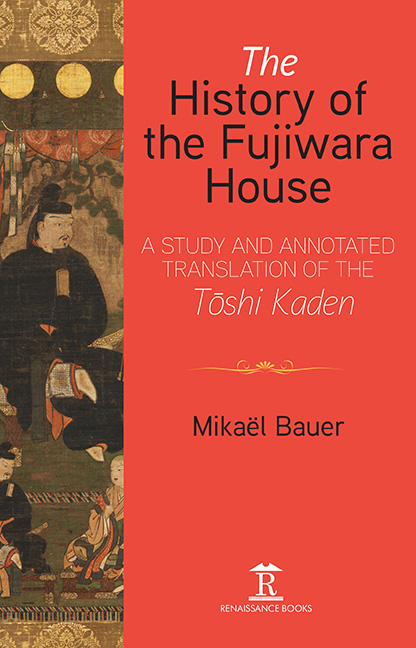Part II - Narratives of the three extant chronicles
Published online by Cambridge University Press: 13 May 2022
Summary
The Chronicle of Kamatari
THE FIRST SECTION of Tōshi Kaden describes the life of the patriarch of the Fujiwara line, Nakatomi no Kamatari, the eldest son of Nakatomi no Mikeko (?–?), information which is also confirmed in Kugyō bunin. In the context of Sovereign Jomei's (593–641) reign, the Nihon Shoki refers to Kamatari's father as Nakatomi no Muraji Mike , and mentions that he was one of four officials. Virtually nothing is known about his father but it is suggested that he was instrumental in the instalment of Jomei. On the death of Jomei in 641, Kamatari witnessed the dispute regarding his succession, a conflict that resulted in the dismissal and eventual forced suicide of Crown Prince Yamashiro no Ōe (?–643), the son of the illustrious Shōtoku Taishi, and the enthronement of Jomei's consort Kōgyoku.
Tōshi Kaden starts exactly at this moment. Having elaborated on Kamatari's intellectual talents and his sense of morality, the chronicle narrates that the courtier Soga no Kuratsukuri (?–645), more commonly referred to as Iruka ‘increased his own fortune’ and controlled the court.
Iruka was the son of Soga no Emishi (?–645), the head of the Soga, who was responsible for the removal of Prince Yamashiro and Jomei's enthronement. After having gained ground at court, he was quick to move against Prince Yamashiro, and during the ensuing standoff led by his son Iruka, the prince and twenty-three other descendants of Shōtoku's line perished. Due to the bloody repression of this part of the imperial family in 642 and his autocratic behaviour at court, discontent grew, and it is here that Kamatari started to play a significant role. The Chronicle of Kamatari details how the Fujiwara patriarch very gradually and in great secrecy started a plot that involved Prince Naka no Ōe, the later sovereign Tenji, and a member of the Soga clan, Soga no Ishikawa no Maro (?–649), whose family had supported Prince Yamashiro. The text describes how the highminded servant Kamatari convinced his later sovereign Naka no Ōe to follow the will of the people and have his uncle Prince Karu enthroned.
- Type
- Chapter
- Information
- The History of the Fujiwara HouseA Study and Annotated Translation of the <i>Tōshi Kaden</i>, pp. 24 - 38Publisher: Amsterdam University PressPrint publication year: 2020



